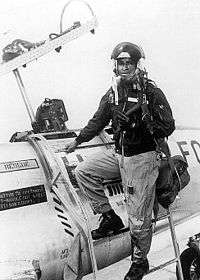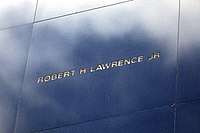Robert Henry Lawrence Jr.
Robert Henry Lawrence Jr. (October 2, 1935 – December 8, 1967) was a United States Air Force officer and the first African-American astronaut.[1][2][3]
Robert Henry Lawrence Jr. | |
|---|---|
 | |
| Born | October 2, 1935 |
| Died | December 8, 1967 (aged 32) |
| Nationality | American |
| Alma mater | Bradley, B.S. 1956 Ohio State, Ph.D. 1965 |
| Occupation | Test pilot |
| Space career | |
| USAF Astronaut | |
| Rank | |
Time in space | None |
| Selection | 1967 USAF MOL Group 3 |
| Missions | None |
Mission insignia | None |
Early years
Born and raised in Chicago, Illinois, Lawrence attended Haines Elementary School and, at age sixteen, graduated in the top 10 percent from Englewood High School in 1952. Four years later in 1956, he graduated from Bradley University with a Bachelor of Science degree in Chemistry. At Bradley, Lawrence became a member of Omega Psi Phi fraternity[4] and distinguished himself as Cadet Commander in the Air Force ROTC and received the commission of second lieutenant in the Air Force Reserve Program.
Air Force

Air Force career
At the age of 21, he was designated as a U.S. Air Force pilot after completing flight training at Malden Air Force Base, Missouri.
At 22, he married Barbara Cress, daughter of Dr. and Mrs. Henry Cress of Chicago. By the time he was 25, he had completed an Air Force assignment as an instructor pilot in the T-33 training aircraft for the German Air Force.
In 1965, Lawrence earned a Ph.D. in physical chemistry from Ohio State University. His doctoral thesis was "The Mechanism Of The Tritium Beta Ray Induced Exchange Reaction Of Deuterium With Methane and Ethane In The Gas Phase."[5][6]
He was a senior USAF pilot, accumulating well over 2,500 flight hours, 2,000 of which were in jets. Lawrence flew many tests in the Lockheed F-104 Starfighter to investigate the gliding flight of various unpowered spacecraft returning to Earth from orbit, such as the North American X-15 rocket-plane. NASA cited Lawrence for accomplishments and flight maneuver data that "contributed greatly to the development of the Space Shuttle."[3]
Astronaut
— Barbara Cress Lawrence, Lawrence's widow, about her late husband's MOL experience.[7]
In June 1967, Lawrence successfully completed the U.S. Air Force Test Pilot School (Class 66B) at Edwards AFB, California. The same month, he was selected by the USAF as an astronaut in the Air Force's Manned Orbital Laboratory (MOL) program, thus becoming the country's first black astronaut.
Lawrence and other MOL astronauts laughed when asked at the announcement "Will you have to sit in the back seat of the capsule?". When asked if his selection was historic for race relations in the United States, Lawrence answered "No, I don't think so. It's another one of those things that we look forward to in civil rights — normal progression". He said that he had faced problems like other blacks, but "Perhaps I have been more fortuate than the others in the opportunities". Donald H. Peterson, chosen for MOL with Lawrence, said "I can't speak for all the people in Mississippi" but that he was not reluctant to work with a black man.[8]

Death and legacy
At age 32, Lawrence was killed in a plane crash at Edwards AFB on December 8, 1967.[1] He was flying backseat in an F-104 as the instructor pilot for flight test trainee Major Harvey Royer, who was learning the steep-descent glide technique. Royer made such an approach, but flared too late.
The airplane struck the ground hard, its main gear failed, it caught fire, and rolled. The canopy shattered and the plane bounced and skidded on the runway for 2,000 feet (610 m). Major Royer ejected upward and survived, with major injuries. The back seat, which delays a moment to avoid hitting the front seat, ejected sideways, killing Lawrence instantly. He was still strapped to his ejector seat; his parachute failed to open and was dragged 75 feet (23 m) from the wreck.
Had Lawrence lived, he likely would have been among the MOL astronauts who became NASA Astronaut Group 7 after MOL's cancellation, all of whom flew on the Space Shuttle.[9][10][11]
During his brief career, Lawrence earned the Air Force Commendation Medal, the Outstanding Unit Citation. On December 8, 1997, his name was inscribed on the Space Mirror Memorial at the Kennedy Space Center in Florida.[3][12][13][14][15]
The 13th Northrop Grumman Cygnus spacecraft, scheduled to launch February 15, 2020, is named the S.S. Robert H. Lawrence in his honor.[16][17][18]
See also
References
- "First Negro astronaut killed in plane crash". Eugene Register-Guard. (Oregon). UPI. December 9, 1967. p. 1A.
- "Negro astronaut is killed in crash". Spokane Daily Chronicle. (Washington). Associated Press. December 9, 1967. p. 2.
- Maj. Robert H. Lawrence Archived 2009-08-10 at the Wayback Machine from the U.S. Air Force's official website
- Epps, Henry. Great African-American Men in America history vol II. p. 62. ISBN 9781300161622.
- Chemistry Department Scholarships Archived 2009-07-19 at the Wayback Machine from the Bradley University website
- The mechanism of the tritium beta-ray induced exchange reactions of deuterium with methane and ethane in the gas phase
- "SECRET ASTRONAUTS – Maj. Robert H. Lawrence Jr, USAF". Pbs.org.
- "First Negro Astronaut Chosen". St. Petersburg Times. UPI. 1967-07-01. pp. 1-A, 6-A. Retrieved 2020-06-25.
- Oberg, James H. (2005-02-23). "The Unsung Astronaut". MSNBC. Retrieved 2011-01-27.
- "NOVA | Astrospies | Secret Astronauts: Maj. Robert H. Lawrence Jr. | PBS". www.pbs.org. Retrieved 2020-05-01.
- Posey, Carl A. "A Sudden Loss of Altitude". Air & Space Magazine. Retrieved 2020-05-01.
- "Robert H. Lawrence, Jr". The Astronauts Memorial Foundation. Retrieved 2020-05-01.
- Garcia, Mark (2018-02-21). "Robert Lawrence: First African-American Astronaut". NASA. Retrieved 2020-05-01.
- Writer, James Hill, Tribune Staff. "1ST BLACK ASTRONAUT ADDED TO SPACE HERO ROSTER". chicagotribune.com. Retrieved 2020-05-01.
- "Defense.gov News Article: First African-American Astronaut Finally Acknowledged". archive.defense.gov. Retrieved 2020-05-01.
- Pearlman, Robert Z. (January 22, 2020). "Northrop Grumman names Cygnus spacecraft for first African American astronaut". Space.com. Retrieved 2020-01-23.
- "Latest Weather Update for Northrop Grumman's CRS-13 Launch: 85% Favorable". NASA. 14 February 2020. Retrieved 14 February 2020.
- "S.S. Robert H. Lawrence, NG-13 Cargo Delivery Mission to the International Space Station" (PDF).
External links
| Wikimedia Commons has media related to Robert Henry Lawrence, Jr.. |